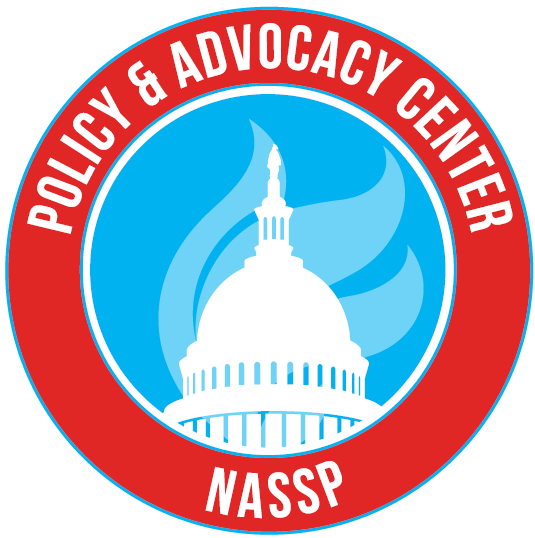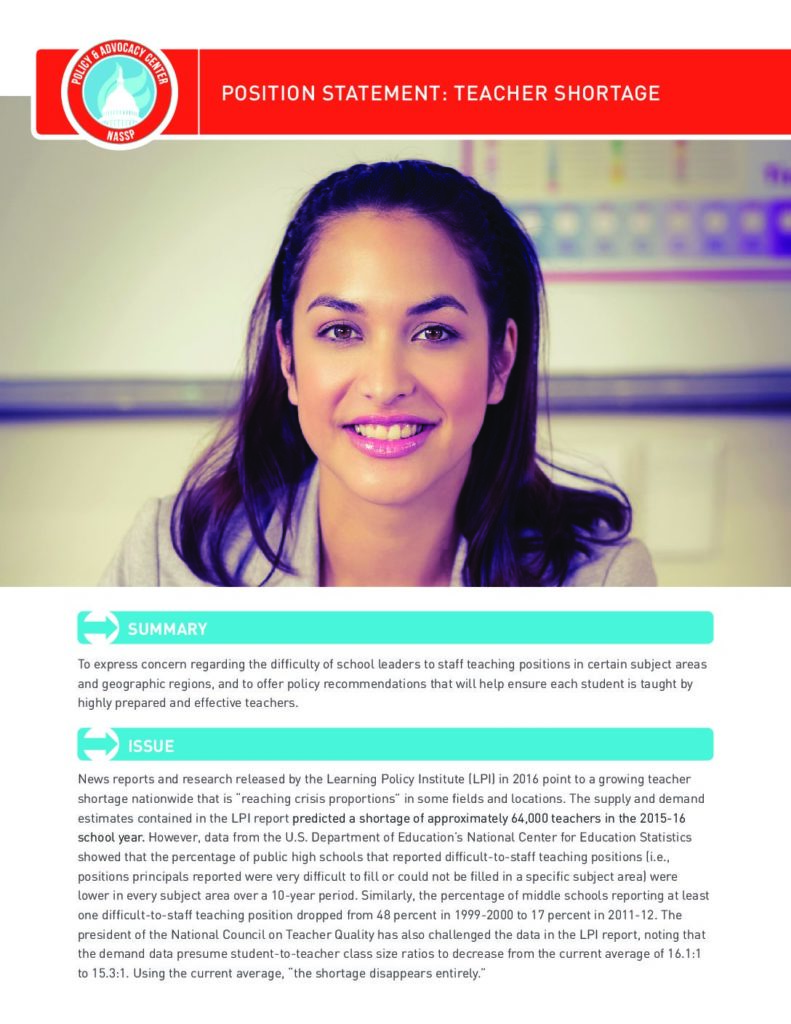To express concern regarding the difficulty of school leaders to staff teaching positions in certain subject areas and geographic regions, and to offer policy recommendations that will help ensure each student is taught by highly prepared and effective teachers.
News reports and research released by the Learning Policy Institute (LPI) in 2016 point to a growing teacher shortage nationwide that is “reaching crisis proportions” in some fields and locations. The supply and demand estimates contained in the LPI report predicted a shortage of approximately 64,000 teachers in the 2015-16 school year. However, data from the U.S. Department of Education’s National Center for Education Statistics showed that the percentage of public high schools that reported difficult-to-staff teaching positions (i.e., positions principals reported were very difficult to fill or could not be filled in a specific subject area) were lower in every subject area over a 10-year period. Similarly, the percentage of middle schools reporting at least one difficult-to-staff teaching position dropped from 48 percent in 1999-2000 to 17 percent in 2011-12. The president of the National Council on Teacher Quality has also challenged the data in the LPI report, noting that the demand data presume student-to-teacher class size ratios to decrease from the current average of 16.1:1 to 15.3:1. Using the current average, “the shortage disappears entirely.”

While the debate on this national data is unsettled, the fact cannot be ignored that many school leaders struggle to find qualified candidates for all of the teaching positions in their schools. According to the Education Commission of the States, urban, rural, high-poverty, high-minority, and low-achieving schools face the most persistent staffing challenges. Middle and high schools, in particular, face challenges in filling positions in special education, math, science, foreign language, applied technology, and ESL. School leaders also report finding teachers of color, male teachers, and bilingual teachers, most representative of the communities they serve, to be extremely difficult.
Although fewer people entered teacher preparation programs during the Great Recession, of greater concern is the number of teachers leaving the profession. LPI estimates that 19 to 30 percent of new teachers leave the profession within the first five years, and the turnover is even greater in high-need schools. While salaries, greater accountability and general working conditions contribute to teacher attrition, building level administrative support has a huge impact on a teacher’s decision to leave or stay in a particular school. An analysis of the 2012-13 Teacher Follow-up Survey by Richard Ingersoll at the University of Pennsylvania found that 66 percent of teachers cited dissatisfaction with school administration as motivation for leaving their schools. LPI also conducted an analysis of the annual Schools and Staffing Survey and found that new teachers who had at least one semester of practice teaching were more than three times less likely to leave the profession after a year than those who had no practice teaching.
To address the teacher shortage, the priority for policymakers and school leaders should be providing the resources and support (time, money, mastery, authority, and autonomy) to recruit and retain the right teachers with the right qualifications in the schools that need them the most.
Guiding Principles
Teacher quality is the single most important school-based factor in student achievement, followed closely by school leadership quality.
Every student should be taught by excellent teachers.
As a leading member of the Coalition for Teaching Quality, NASSP supports its mission to ensure a diverse, talented, and sustainable teaching force that can prepare all students for a variety of postsecondary options and to be contributing citizens in their communities.
Recommendations
Recommendations for Federal Policymakers
- Encourage the National Center for Education Statistics to collect data on teacher recruitment and retention that would allow for a comparative analysis of the teacher shortage in states and districts by school level (elementary, middle, high); subject area; geographic region (rural, suburban, urban); gender; and race.
- Develop a federal campaign to promote the education profession and encourage more individuals to become teachers and principals.
- Reauthorize the Higher Education Act and ensure that teacher preparation programs include a strong residency program and ongoing mentoring and support for new educators.
- Authorize matching grants for states and districts that implement high-quality teacher preparation programs.
- Offer incentives for states to design reciprocity agreements and portability options that would allow teachers to easily transfer their license and certification from state to state.
Recommendations for State Policymakers
- Revise teacher certification and licensure requirements so that teacher preparation programs only accept and graduate individuals who demonstrate the capacity to be high-caliber teachers.
- Align state licensing and certification levels with school grade configurations, i.e. K-6, 5-9, 7-12 to increase the quantity and quality of potential applicant pools.
- Ensure that teacher preparation programs are focusing their recruitment and training efforts in grades and subject areas that will meet local workforce needs.
- Require new teachers to be “profession-ready” when they become the teacher of record in a school. At a minimum, they should:
- Hold a bachelor’s degree and demonstrate in-depth content knowledge in their area of licensure;
- Fulfill the requirements of a state-approved preparation program that includes clinical experiences using models of accomplished practice by instructors with K-12 experience, as well as promotes cultural responsiveness and the ability of teachers to address the individual learning needs and backgrounds of all students;
- Complete a comprehensive residency program in which a teacher preparation program and a local school district partner to engage teacher residents in a series of school-based experiences and teaching enrichment opportunities under the guidance of accomplished educators; and
- Demonstrate proficiency through a valid and reliable classroom-based performance assessment.
- In collaboration with all education stakeholders, develop a teacher evaluation and support system that includes the following components:
- Feedback and reflective practice;
- Multiple measures of classroom practice, student learning, and other evidence related to the teacher’s contribution to schoolwide improvement; and
- High-quality training, credentialing, and ongoing professional development for principals to coach and mentor teachers to improve their practice.
- Continue loan forgiveness programs for teachers that work in high-need schools or subject areas.
- Develop teacher recruitment strategies that include sufficient and sustainable financial incentives coupled with efforts to empower school principals with the authority and autonomy to improve working conditions for teachers.
- Invest in principal preparation, training, and empowerment to help them create school cultures that have a positive impact on teacher retention by fostering creative and innovative practices.
- Examine how state policies on seniority and teacher effectiveness impact the teacher shortage during budget shortfalls.
Recommendations for Teacher Preparation Program Providers
- Vet preservice teachers thoroughly, before allowing them to enter the job market or workforce.
- Put less emphasis on teacher candidates attaining a teaching position through inflated recommendations, and more emphasis on them keeping a teaching position through extended support.
- Provide more practicum opportunities through school partnership professional development prior to the student-teaching experience.
- To the extent possible, hire practicing educators who have current K-12 classroom experience to teach preservice teachers.
- Provide explicit instruction on personality inventories, work styles, self-reflection, having difficult conversations, and how to work collaboratively as part of a team.
Recommendations for District Policymakers
- Develop partnerships with teacher preparation programs and offer streamlined induction opportunities for student teachers to work in your schools.
- Offer incentives for high school graduates to return as teachers after receiving the appropriate credentials and preparation.
- Negotiate with teacher union leaders, if applicable, and provide significant and sustainable compensation for teachers and principals to serve in leadership roles in their schools, i.e. release time, stipends, authority, etc.
- Examine how district policies on seniority and teacher effectiveness impact the teacher shortage during budget shortfalls.
- Offer teacher leaders and principals opportunities to play a meaningful role in shaping district policies and practice.
Recommendations for Principals
- Develop a school culture that provides meaningful decision-making roles for teachers and is committed to a shared vision and mission focused on student behavioral and academic success.
- Provide teachers with the opportunities and compensation to serve as mentors, instructional coaches, or master teachers, and allow them to take on increased responsibility for professional learning, curriculum, or school improvement activities.
- Foster opportunities for collaboration to improve student achievement such as teacher teams and regularly scheduled common planning time through flexibility within the teacher employment contract.
- Provide stipends for teachers to offer clubs and other opportunities for students who are aspiring teachers to learn about the field of education and work with students.
Resources
- Center for Public Education. (2016). Fixing the holes in the teacher pipeline: An overview of teacher shortages. Retrieved from http://www.centerforpubliceducation.org/Main-Menu/Staffingstudents/An-Overview-of-Teacher-Shortages-At-a-Glance/Overview-of-Teacher-Shortages-Full-Report-PDF.pdf
- Coalition for Teaching Quality. (2014). Excellent educators for every child: A policy roadmap for transforming the teaching and principal profession. Retrieved from http://coalitionforteachingquality.org/images/upload/Wheel_Doc.pdf
- Education Commission of the United States. (2016). Teacher shortages: What we know. Retrieved from http://www.ecs.org/teacher-shortages/
- Ingersoll, R. (2015). Why schools have difficulty staffing their classrooms with qualified teachers? [Powerpoint slides]. Retrieved from http://www.ncsl.org/documents/capitolforum/2015/onlineresources/NCSL_Talk_Dec_2015.pdf
- National Association of Elementary School Principals and National Association of Secondary School Principals. (2014). Supporting principals in implementing teacher evaluation systems. Retrieved from http://blog.nassp.org/wp-content/uploads/2014/02/NASSP_NAESP-Joint-Policy-Brief_FINAL_2.12.14.pdf
- National Association of Secondary School Principals. (2011). Breaking ranks: The comprehensive framework for school improvement. Reston, VA: Author.
- Learning Policy Institute. (2016). Solving the teacher shortage: How to attract and retain excellent educators. Palo Alto, CA: Author.
- Learning Policy Institute. (2016). A coming crisis in teaching? Teacher supply, demand, and shortages in the U.S. Palo Alto, CA: Author.
- U.S. Department of Education. (2015). Teaching vacancies and difficult-to-staff teaching positions in public schools. Retrieved from http://nces.ed.gov/pubs2015/2015065.pdf
- Walsh, K. (2016, September). The ghost of teacher shortages past… Teacher Quality Bulletin Newsletter. Retrieved from http://www.nctq.org/commentary/article.do?id=293

